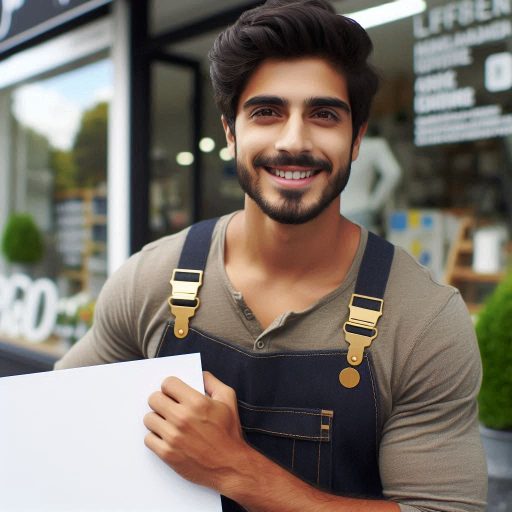Introduction
Keeping up with fashion design trends is crucial for anyone in the fashion industry.
The world of fashion evolves rapidly, with trends shifting almost overnight.
For designers, staying current ensures their work remains fresh, relevant, and appealing.
This adaptability is essential for creating collections that resonate with contemporary audiences.
By understanding and integrating the latest trends, designers can craft pieces that not only meet market demands but also set new standards.
For fashion professionals, awareness of trends extends beyond design.
It informs marketing strategies, product development, and consumer engagement.
Trend knowledge helps marketers create compelling campaigns that align with current interests and drive sales.
It also enables fashion brands to position themselves effectively in a competitive landscape.
Staying updated with trends allows individuals in the fashion industry to anticipate shifts and adjust their approaches accordingly.
It fosters innovation and ensures that both designers and marketers can leverage emerging trends to enhance their creative and business strategies.
Embracing these trends is key to achieving long-term success and maintaining a competitive edge in the dynamic fashion world.
Attend Fashion Shows and Events
The Benefits of Attending Fashion Shows
- Direct Exposure to Trends: Fashion shows present collections from top designers, giving you immediate insight into upcoming trends and styles.
Observing these trends helps you stay ahead of the curve and adapt your designs accordingly. - Networking Opportunities: Events offer a chance to meet and connect with industry professionals, designers, and influencers.
Building these relationships can open doors for collaborations, mentorships, and career advancement. - Inspiration and Creativity: Seeing new collections and innovative designs can spark your creativity.
Fashion shows often push boundaries, encouraging you to experiment with your own designs and incorporate new elements. - Understanding Market Preferences: Events often highlight what is trending among consumers and buyers.
This understanding helps you tailor your designs to meet market demands and preferences.
Tips on how to find and attend relevant events
- Research Industry Calendars: Fashion weeks are major events in the fashion world.
Check the official calendars for New York, Paris, Milan, and London fashion weeks. These are key venues for discovering new trends. - Follow Fashion Industry News: Stay updated with fashion magazines, blogs, and online platforms.
Websites like Vogue, Harper’s Bazaar, and Fashionista often list upcoming events and shows. - Join Fashion Associations: Organizations such as the Council of Fashion Designers of America (CFDA) and British Fashion Council (BFC) actively share event updates.
They also provide the latest industry news. Membership grants exclusive access to these events. - Utilize Social Media: Follow designers, brands, and fashion influencers on platforms like Instagram and Twitter.
They frequently post about upcoming shows and events, offering valuable insights into where to attend. - Network with Industry Peers: Connect with fellow designers, stylists, and fashion enthusiasts.
They can provide recommendations and insider information on not-to-miss events. - Attend Trade Shows and Expos: Fashion trade shows and expos often feature emerging designers and new collections.
Events like MAGIC in Las Vegas and Premiere Vision in Paris are excellent for discovering fresh trends and materials. - Register Early: Many fashion shows and events require advance registration.
Ensure you sign up early to secure your spot and avoid missing out on key experiences.
By attending fashion shows and events, you gain invaluable insights into the latest trends, network with key industry players, and fuel your creativity.
Stay engaged with the fashion world to continuously evolve and remain relevant in this ever-changing industry.
Read: Freelance vs. In-House Costume Design Jobs
Follow Fashion Designers and Influencers
The significance of following popular designers and influencers
- Real-Time Updates: Designers and influencers offer immediate glimpses into upcoming trends through social media, blogs, and fashion shows.
Their posts often feature the latest collections, style innovations, and behind-the-scenes content that can inspire your fashion choices. - Trend Forecasting: Designers and influencers often predict trends before they hit the mainstream.
By observing their work and statements, you can stay ahead of the curve and incorporate new trends into your wardrobe early. - Style Inspiration: Following these figures can provide diverse style inspirations.
Whether you’re looking for everyday outfits or high-fashion looks, their curated content helps in discovering new ways to elevate your style.
Suggestions on who to follow for trend updates
- Anna Wintour: As the editor-in-chief of Vogue, Anna Wintour is a key player in fashion.
Her perspectives and endorsements are highly influential in shaping fashion trends. - Virgil Abloh: The late Virgil Abloh, founder of Off-White and artistic director at Louis Vuitton, had a significant impact on contemporary fashion.
His innovative designs and collaborations continue to influence the industry. - Chiara Ferragni: A renowned fashion blogger and entrepreneur, Chiara Ferragni offers insights into both high fashion and street style.
Her posts frequently feature trendy outfits and fashion tips. - Kendall Jenner: A prominent model and influencer, Kendall Jenner’s style often sets trends.
Following her can provide inspiration from both runway and everyday looks. - Rihanna: As a singer and fashion icon, Rihanna’s unique style and her fashion brand, Fenty, influence trends globally.
Her bold fashion choices often spark new trends. - Tavi Gevinson: A fashion blogger and actress, Tavi Gevinson’s style is known for its eclectic and avant-garde elements.
She provides a fresh perspective on emerging trends. - Timothée Chalamet: Timothée Chalamet, an actor famous for daring fashion, often wears bold, unconventional outfits. He sets new trends in menswear.
- Leandra Medine Cohen: Founder of the blog Man Repeller, Leandra Medine Cohen offers quirky and unique fashion insights.
Her style is often an excellent source of inspiration for those looking to experiment.
By following these designers and influencers, you can stay updated on the latest fashion trends and gain inspiration for your personal style.
Their content serves as a valuable resource for understanding and adapting to the ever-evolving world of fashion.
Read: Networking Events for Costume Designers
Read Fashion Magazines and Blogs
The role of fashion magazines and blogs in staying informed
Fashion magazines and blogs are crucial for staying updated with current trends. They offer insights into the latest styles, designers, and industry movements.
Here’s how you can leverage these resources effectively.
The Role of Fashion Magazines
Fashion magazines provide a visual feast of current trends. They showcase seasonal collections and highlight key pieces from top designers.
Reading these magazines helps you understand which styles are making waves in the fashion world.
Magazines often feature interviews with designers and industry insiders. These interviews can offer unique perspectives and insider information.
They also cover fashion events, runway shows, and exclusive launches.
In addition, magazines provide style guides and trend forecasts. These guides help you anticipate what will be in vogue in the coming months.
They also offer practical tips on incorporating trends into your wardrobe.
The Role of Fashion Blogs
Fashion blogs offer a more personal and often immediate view of trends.
Bloggers provide unique perspectives and share how they interpret current styles.
They also cover niche trends that might not be highlighted in mainstream media.
Blogs often feature street style photos and reviews of fashion events.
This content can give you a real-world view of how trends are being applied.
Many bloggers also provide DIY tips and how-to guides for creating trendy looks on a budget.
Blogs often discuss fashion-related topics like sustainability and emerging designers.
This information can help you stay informed about broader industry movements and ethical considerations.
Popular magazines and blogs to follow for trend insights
Recommended Fashion Magazines
To stay ahead in fashion, consider following these popular magazines:
- Vogue – Known for its comprehensive coverage of fashion trends and designer collections.
- Harper’s Bazaar – Offers style advice and features on emerging trends.
- Elle – Covers a mix of high fashion and street style, providing diverse trend insights.
- InStyle – Focuses on fashion that is accessible and wearable, with trend recommendations for everyday style.
- W Magazine – Highlights high fashion and luxury trends with an emphasis on editorial photography.
Recommended Fashion Blogs
Here are some influential fashion blogs to follow:
- The Sartorialist – Offers street style photography showcasing real-world fashion trends.
- Man Repeller – Provides a humorous and insightful take on fashion trends and personal style.
- Fashion Toast – Features high-fashion looks and style inspiration from around the world.
- Style Bubble – Covers avant-garde fashion and emerging trends with a focus on unique styles.
- Who What Wear – Offers trend forecasts and style tips, focusing on accessible fashion.
By regularly reading fashion magazines and blogs, you’ll stay informed about the latest trends and how to incorporate them into your style.
Read: Building a Portfolio for Costume Design
Utilize Social Media Platforms
How social media can be a valuable tool for trend spotting
Social media has become an essential tool for fashion designers seeking to stay on top of trends.
Platforms like Instagram, Pinterest, and TikTok are invaluable for spotting emerging styles and gaining inspiration.
By actively engaging with these platforms, designers can keep their designs fresh and relevant.
Examples of platforms where fashion trends are often discussed
Instagram is a prime resource for fashion trend spotting. Designers should follow influential fashion accounts, brands, and industry leaders.
Instagram’s visual nature allows for immediate exposure to new collections, street style, and influencer outfits.
Regularly browsing the Explore page also helps uncover trending looks and styles.
Pinterest offers a different yet complementary approach to trend spotting.
The platform allows users to create boards of their favorite styles and trends.
Designers can search for specific fashion trends or browse through curated boards for inspiration.
Pinterest’s algorithm also highlights trending pins based on user engagement.
TikTok
TikTok has rapidly emerged as a significant player in fashion trend dissemination.
The platform’s short video format showcases real-time fashion trends and styling tips.
Designers can follow popular fashion creators and hashtags to see the latest trends in motion.
TikTok also enables users to interact with trends by participating in challenges and creating their own content.
Transform Your Career Today
Unlock a personalized career strategy that drives real results. Get tailored advice and a roadmap designed just for you.
Start NowTwitter is another valuable platform for trend tracking.
By following fashion news accounts and industry insiders, designers can stay updated on the latest fashion events and announcements.
Twitter’s real-time nature ensures that designers receive updates as trends emerge.
YouTube
YouTube offers in-depth insights into fashion trends through video content.
Fashion vlogs, runway shows, and trend analysis videos provide a detailed look at current and upcoming trends.
Designers can watch fashion week recaps and review styling tutorials to better understand how trends are evolving.
By leveraging these social media platforms, designers gain access to a vast array of fashion insights and inspiration.
Regular interaction with these channels allows designers to stay informed about the latest trends and adapt their designs accordingly.
Social media platforms are powerful tools for fashion designers. They provide immediate access to trend updates and styling inspiration.
Utilizing Instagram, Pinterest, TikTok, Twitter, and YouTube helps designers keep their collections current and appealing to the modern fashion consumer.
Read: Famous Costume Designers in Hollywood

Join Fashion Design Communities
The benefits of participating in fashion design communities
Being part of fashion design communities can be incredibly beneficial for staying up-to-date with trends.
You will connect with like-minded individuals and access valuable resources. These will help you keep your designs fresh and innovative..
One of the main benefits of joining fashion design communities is the opportunity to network with other designers, industry professionals, and fashion enthusiasts.
This networking can lead to collaborations, mentorship opportunities, and even potential job leads.
By surrounding yourself with individuals who are passionate about fashion, you can gain valuable insights and perspectives that can inspire your own work.
Additionally, participating in fashion design communities allows you to showcase your own work and receive feedback from others.
This feedback can help you improve your designs, identify areas for growth, and stay informed about what is currently trending in the industry.
Constructive criticism from peers can be a valuable tool for growth and development as a designer.
Advice on how to find and join relevant groups or forums
So, how can you find and join relevant fashion design communities?
One of the easiest ways is to start by searching for Facebook groups, LinkedIn groups, or online forums dedicated to fashion design.
These platforms often have a wealth of information and resources for designers of all levels.
Look for groups that align with your specific interests or niche within the fashion industry.
Another option is to attend local meetups, workshops, or events that cater to fashion designers.
These in-person gatherings can provide a more personal and interactive way to connect with others in the industry.
You may even have the chance to collaborate on projects or attend informative workshops that can help you stay ahead of the curve in terms of trends and techniques.
Lastly, don’t forget about the power of networking through social media platforms like Instagram, Twitter, and Pinterest.
Follow other designers, brands, and fashion influencers to stay informed about what is popular and trending in the industry.
Engage with others by liking, commenting, and sharing posts to build connections and expand your network within the fashion community.
Overall, joining fashion design communities can be a valuable investment in your career as a designer.
Network with industry professionals and receive feedback on your work. Stay informed about the latest trends.
Take the time to find and join relevant communities that align with your interests and goals, and watch your design skills and knowledge flourish as a result.
Experiment with Different Styles
Keeping up with fashion design trends involves more than just following the latest looks; it requires experimenting with different styles.
Embracing this approach can elevate your wardrobe and enhance your personal style.
Here’s how to effectively experiment with various styles and incorporate trends into your fashion choices.
Encourage readers to try out new and different styles
- Explore Fashion Shows and Runways: Fashion shows present cutting-edge designs.
Watch them to discover emerging trends and styles. Use these inspirations to experiment with new looks. - Visit Trendy Boutiques and Stores: Trendy boutiques often carry the latest styles.
Visit them to find unique pieces that stand out. Incorporate these items into your wardrobe for a fresh look. - Try Different Silhouettes and Cuts: Experiment with various silhouettes, like oversized or tailored garments.
This helps you understand what works best for your body type. - Mix and Match Patterns and Textures: Combining different patterns and textures can create unique outfits.
Don’t be afraid to mix stripes with florals or leather with lace. - Play with Accessories: Accessories like hats, scarves, and jewelry can transform any outfit.
Try bold accessories to give your outfits a trendy twist.
Ways to incorporate trends into personal fashion choices
- Start Small: Begin by adding one trendy item to your outfit. This approach allows you to test trends without overwhelming your personal style.
- Create a Capsule Wardrobe: Build a wardrobe of versatile pieces that incorporate current trends. This makes it easier to mix and match outfits while staying on trend.
- Adjust Trends to Fit Your Style: Modify trends to suit your personal taste. If a trend doesn’t align with your style, adapt it to make it work for you.
- Follow Fashion Influencers: Fashion influencers often showcase how to wear current trends.
Follow them for inspiration and ideas on how to incorporate these trends into your daily outfits. - Attend Fashion Workshops: Fashion workshops and styling sessions offer practical advice on experimenting with new styles.
They provide insights on how to incorporate trends into your wardrobe effectively. - Stay Open-Minded: Keep an open mind when experimenting with new styles.
Fashion is about self-expression, so allow yourself to explore and enjoy the process.
By experimenting with different styles and incorporating trends into your personal fashion choices, you can keep your wardrobe fresh and exciting.
Embrace new looks, play with trends, and make them your own. This approach not only keeps you updated but also helps you develop a unique and stylish wardrobe.
Keep an Eye on Runway Collections
The importance of analyzing runway collections for trend forecasting
- Trend Identification: Runway collections showcase the latest trends straight from designers’ minds. They set the stage for what will be in vogue next season.
- Influence on the Market: Designers often introduce new concepts and styles on the runway.
These ideas trickle down to mainstream fashion, influencing what you see in stores. - Forecasting Trends: By studying runway shows, you can predict upcoming trends before they hit the streets. This insight helps you stay ahead in the fashion game.
How to interpret runway trends and apply them to everyday fashion
- Observe Key Themes: Look for recurring themes in multiple runway shows. These often indicate emerging trends.
Themes might include specific colors, fabrics, or silhouettes. - Analyze Designers’ Choices: Pay attention to how different designers interpret similar trends.
Notice variations in style, which can offer unique insights into the trend’s evolution. - Track Color and Fabric Trends: Runway shows highlight color palettes and fabric innovations.
Take note of these elements, as they often dictate seasonal color trends and material preferences. - Understand the Context: Trends on the runway often reflect broader cultural and social contexts.
Consider how these trends fit into the current mood or societal shifts. - Apply Trends to Everyday Fashion: Not all runway looks are practical for daily wear.
Adapt the trends by focusing on key elements, such as colors or patterns, rather than exact replicas. - Incorporate Trend Elements: Integrate runway-inspired elements into your wardrobe.
For instance, if oversized blazers are trending, find ways to incorporate them in a way that suits your style.
Practical Tips for Application
- Create Mood Boards: Compile images from runway shows that resonate with you. This visual aid can help in translating runway trends into wearable outfits.
- Follow Fashion Influencers: Many fashion influencers and bloggers provide practical advice on adapting runway trends.
They offer a bridge between high fashion and everyday style. - Experiment with Accessories: Accessories are an easy way to incorporate runway trends.
Try out trend-inspired shoes, bags, or jewelry to add a fresh touch to your outfits.
By consistently analyzing runway collections, you gain valuable insights into emerging fashion trends.
Use this information to refine your personal style and stay ahead of the curve.
Conclusion
Keeping up with fashion design trends is crucial for remaining competitive in a rapidly changing industry.
To stay ahead, immerse yourself in various resources and strategies.
Start by regularly following top fashion blogs and influencers, as they offer timely updates and insights into the latest styles and trends.
Attending fashion shows and industry events provides firsthand experience of new collections and innovations, offering a unique perspective on what’s trending.
Subscribing to leading fashion magazines is another effective method.
These publications often feature trend forecasts, expert opinions, and detailed analyses that can help you anticipate and understand emerging trends.
Engage with online fashion communities and forums where designers, enthusiasts, and critics share ideas and discuss the latest trends.
This exchange of ideas can offer fresh perspectives and inspiration.
Social media platforms like Instagram, Pinterest, and TikTok are also powerful tools for staying updated.
Follow relevant hashtags and accounts to see real-time updates on popular styles and emerging trends.
Additionally, use trend forecasting tools and apps that analyze fashion data and predict future trends based on current patterns.
[E-Books for Sale]
The Big Book of 500 High-Paying Jobs in America: Unlock Your Earning Potential
$19.99 • 500 High-Paying Jobs • 330 pages
Explore 500 high-paying jobs in America and learn how to boost your career, earn more, and achieve success!
See All 500 High-Paying Jobs of this E-Book
1001 Professions Without a Degree: High-Paying American Jobs You Can Start Now
$19.99 • 1001 Professions Without a Degree • 174 pages
Discover 1001 high-paying jobs without a degree! Unlock career tips, skills, and success strategies for just $19.99!




